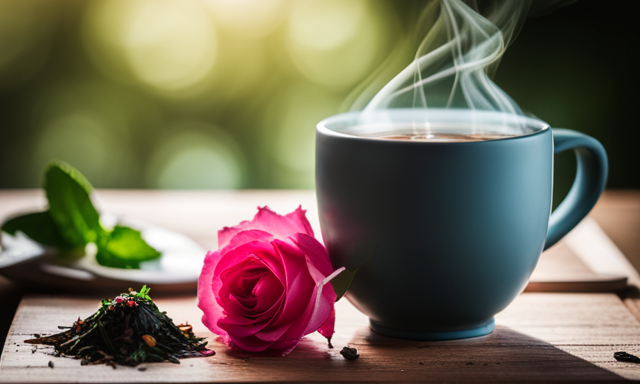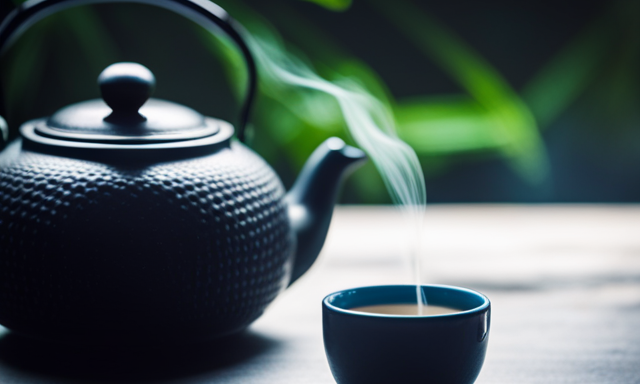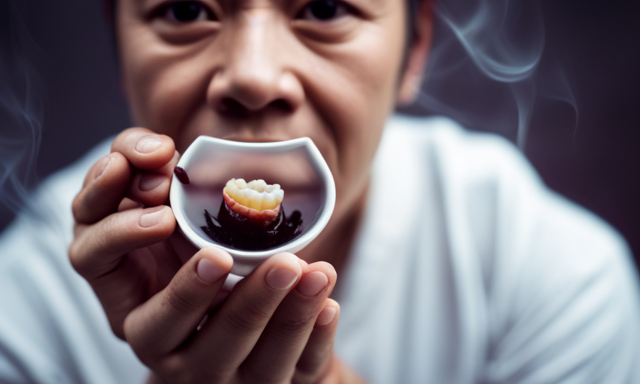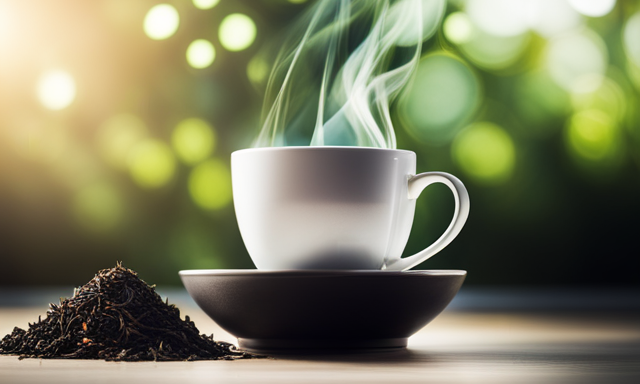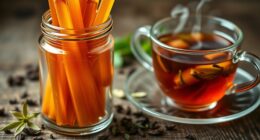Did you know that tea is the second most consumed beverage in the world, after water? It’s true! And with so many different types to choose from, it can be overwhelming to know which one is best for your health. That’s why I’m here to help you decide between oolong and green tea.
Both of these teas have been praised for their numerous health benefits, but they also have their own unique qualities. In this article, we will explore the differences between oolong and green tea, as well as the specific health benefits they offer. We’ll also compare their caffeine levels, impact on weight loss, skin benefits, potential side effects, and provide some brewing and serving tips.
By the end, you’ll have all the information you need to make an informed decision and choose the right tea for your health.
Let’s dive in!
Key Takeaways
- Both oolong and green tea have numerous health benefits, including reducing signs of aging and protecting against UV damage.
- Oolong tea has the added benefit of improving digestion and reducing the risk of heart disease.
- Green tea aids in weight loss by increasing metabolism and promoting fat burning.
- It is important to consider personal preferences and health goals when choosing between oolong and green tea, as they have different flavors and brewing recommendations.
Differences between Oolong and Green Tea
Let’s dive into the differences between oolong and green tea and discover which one is better for your health!
When it comes to taste, oolong tea has a rich and complex flavor profile, while green tea has a more grassy and vegetal taste.
The brewing methods for these teas also differ. Oolong tea is typically steeped in hot water for a shorter period of time, around 3-5 minutes, while green tea is often brewed at a lower temperature for a longer duration, around 2-3 minutes.
Both teas offer their own unique set of health benefits, which we will explore in the next section. But for now, let’s focus on the differences in taste and brewing methods between oolong and green tea.
Health Benefits of Oolong Tea
Try incorporating oolong tea into your daily routine for its potential health benefits. Oolong tea has been shown to improve digestion, boost metabolism, and enhance mental alertness. Additionally, research suggests that oolong tea may have a positive impact on heart health. Studies have found that regular consumption of oolong tea may help reduce the risk of heart disease by lowering blood pressure and cholesterol levels. Oolong tea is also known to aid in digestion by promoting the production of digestive enzymes and relieving symptoms of indigestion. To give you a better idea of the health benefits of oolong tea, here is a table summarizing its potential effects on heart health and digestion:
| Health Benefits of Oolong Tea |
|---|
| Improves digestion |
| Boosts metabolism |
| Enhances mental alertness |
Now, let’s explore the health benefits of green tea.
Health Benefits of Green Tea
Green tea is renowned for its numerous health benefits, including improved brain function, increased fat burning, and a reduced risk of certain types of cancer. It contains bioactive compounds that can improve brain function and help you stay focused and alert.
Green tea also boosts metabolism and promotes fat burning, making it a great addition to any weight loss regimen. In addition, it contains powerful antioxidants that can help protect against certain types of cancer, such as breast, prostate, and colorectal cancer.
Drinking green tea regularly may also benefit heart health by reducing LDL cholesterol levels and improving blood flow. Moreover, one of the key differences between green tea and black tea is the level of oxidation during processing. Green tea is less oxidized, which helps retain more of its beneficial compounds.
Now let’s compare the caffeine levels of these two teas.
Comparing Caffeine Levels
If you’re looking for a morning pick-me-up, did you know that comparing the caffeine levels in black tea and green tea can help you make an informed choice?
When it comes to caffeine content, both oolong and green tea contain less caffeine than black tea, making them a great alternative for those looking for a milder boost.
Here are some key points to consider when comparing taste preferences and impact on digestion:
-
Taste preferences: Oolong tea has a slightly stronger and more robust flavor compared to the milder and grassier taste of green tea. It ultimately depends on your personal preference and whether you enjoy a bolder or more delicate tea.
-
Impact on digestion: Oolong tea is known to aid digestion by reducing inflammation in the digestive tract and promoting the growth of beneficial gut bacteria. Green tea, on the other hand, contains catechins that can help improve digestion and prevent stomach-related issues.
When it comes to impact on weight loss, both oolong and green tea have been associated with boosting metabolism and aiding in weight management.
Transitioning into the subsequent section, let’s explore the effects of these teas on weight loss.
Impact on Weight Loss
When it comes to weight loss, both oolong tea and green tea have been touted as effective aids. Oolong tea is believed to help increase metabolism and fat burning, while green tea is known for its ability to boost metabolism and enhance fat oxidation. However, determining which is more effective for shedding pounds ultimately depends on individual factors such as diet, exercise, and overall lifestyle.
Oolong tea and weight loss
Oolong tea is a fantastic choice for those looking to shed a few pounds and feel amazing. Research suggests that oolong tea can help boost metabolism and promote weight loss. The polyphenols found in oolong tea have been shown to increase fat oxidation and improve fat metabolism.
Additionally, oolong tea has been found to regulate blood sugar levels, which can prevent spikes and crashes that often lead to cravings and overeating. By maintaining stable blood sugar levels, oolong tea can support weight loss efforts by reducing the intake of excess calories.
Now, let’s delve into the benefits of green tea for weight loss and see how it compares to oolong tea.
Green tea and weight loss
Looking to shed a few pounds and feel amazing? Green tea may be just what you need to boost your weight loss efforts. Here are three ways that green tea can help with weight loss:
-
Boosts metabolism: Green tea contains catechins, a type of antioxidant that’s been shown to increase metabolism. By speeding up your metabolism, green tea can help you burn more calories throughout the day.
-
Enhances fat oxidation: The catechins in green tea have also been found to increase the body’s ability to burn fat. This means that green tea can help your body break down and use stored fat as a source of energy.
-
Suppresses appetite: Drinking green tea can help you feel fuller for longer, reducing the urge to snack or overeat. This can be especially beneficial for those trying to cut down on calorie intake.
Green tea’s effects on metabolism and fat burning make it a great option for weight loss. In the next section, we’ll explore which tea, green or oolong, is more effective for shedding pounds.
Which is more effective for shedding pounds
To shed pounds effectively, it’s important to understand the benefits of both green and oolong tea. Both types of tea have been shown to have potential weight loss benefits due to their impact on metabolism.
Green tea, in particular, is often praised for its ability to boost metabolism and increase fat oxidation. It contains catechins, which are antioxidant compounds that have been linked to weight loss.
Oolong tea, on the other hand, has been found to enhance fat metabolism and promote weight loss by increasing energy expenditure. Studies have shown that both green and oolong tea can help in shedding pounds, but the effectiveness may vary depending on individual factors.
Moving on to the next section about ‘skin benefits’, it’s important to note that these teas offer more than just weight loss benefits.
Skin Benefits
Curious about which type of tea can do wonders for your skin? Look no further than oolong and green tea. These two varieties are packed with antioxidants that can benefit your skin in multiple ways. Here are four key points to consider:
-
Comparing antioxidant levels: Both oolong and green tea contain high levels of antioxidants, such as catechins and polyphenols, which help fight free radicals and protect your skin from damage.
-
Impact on skin aging: Studies have shown that the antioxidants in green and oolong tea can help reduce the signs of aging, such as wrinkles and fine lines, by promoting collagen production and improving skin elasticity.
-
Protection against UV damage: The polyphenols in both teas have been found to have a photoprotective effect, shielding your skin from harmful UV rays.
-
Hydration and skin health: Both oolong and green tea can contribute to overall skin hydration, improving its texture and appearance.
Now, let’s delve into the potential side effects of these teas.
Potential Side Effects
When it comes to the potential side effects of oolong tea and green tea, it’s important to be aware of any potential risks. While both types of tea are generally considered safe for most people, they can still have some side effects. These may include digestive issues, caffeine sensitivity, and potential interactions with certain medications. It’s always wise to consume these teas in moderation and consult with a healthcare professional if you have any concerns or pre-existing health conditions.
Oolong tea side effects
If you’re a tea lover, you’ll be glad to know that oolong tea has minimal side effects, with only 1 in 100 people experiencing any adverse reactions.
Oolong tea has been found to have positive effects on digestion, as it contains polyphenols that can help improve gut health and promote regular bowel movements. Additionally, research suggests that oolong tea may have benefits for heart health. Studies have shown that regularly consuming oolong tea can help reduce the risk of developing heart disease by improving cholesterol levels and reducing blood pressure.
These findings make oolong tea a great choice for those looking to support their digestive system and maintain a healthy heart.
Moving on to green tea side effects, it’s important to consider the potential risks associated with this popular beverage.
Green tea side effects
You’ll be relieved to know that green tea is generally safe to consume, but you should be aware of a few potential side effects. Green tea has been studied for its many health benefits, including its positive effects on heart health and brain function. It contains antioxidants called catechins, which have been shown to reduce the risk of heart disease and improve blood vessel function. Additionally, green tea contains caffeine and L-theanine, which can enhance brain function and improve mood and concentration. However, it’s important to note that excessive consumption of green tea can lead to side effects such as caffeine sensitivity, stomach upset, and liver damage. Therefore, it’s best to enjoy green tea in moderation to reap its health benefits without any adverse effects. Moving on to precautions and moderation…
Precautions and moderation
To fully savor the benefits of green tea, it’s crucial to strike a balance between indulgence and moderation. While green tea is generally safe for most people, there are a few precautions to keep in mind.
Pregnant women should exercise caution and limit their consumption of green tea due to its caffeine content. It’s advisable to consult with a healthcare professional to determine a safe amount.
Similarly, when it comes to children, it’s important to moderate their intake of green tea. While small amounts are generally considered safe, excessive consumption of caffeine can have negative effects on their developing bodies.
Now, let’s move on to the next section where we’ll explore some brewing and serving tips for the perfect cup of green tea.
Brewing and Serving Tips
When brewing and serving tea, remember to steep oolong or green tea leaves for the appropriate amount of time to ensure the best flavor and health benefits. Here are some brewing techniques and serving suggestions to enhance your tea experience:
-
Water temperature: For oolong tea, use water that’s around 185-205°F (85-95°C), while green tea requires a slightly lower temperature of 160-180°F (70-80°C). This helps preserve the delicate flavors and prevent bitterness.
-
Steeping time: Oolong tea generally needs to steep for 3-5 minutes, while green tea should be steeped for 2-3 minutes. Adjust the steeping time according to your taste preference, but be careful not to oversteep as it can result in a bitter taste.
-
Serving suggestions: Oolong tea is often enjoyed without milk or sweeteners to fully appreciate its complex flavors. Green tea can be served plain or with a touch of honey or lemon for added taste.
By following these brewing and serving tips, you can savor the full potential of oolong or green tea. Now, let’s explore how to choose the right tea for you.
Choosing the Right Tea for You
When it comes to choosing the right tea for me, I consider my personal preferences and my specific health goals. I love experimenting with different varieties, and I believe that it’s important to listen to my taste buds and choose teas that I genuinely enjoy drinking.
Additionally, I take into account the potential health benefits of different types of teas and how they align with my goals. Whether it’s boosting my immune system or aiding digestion, I consider these factors when selecting my tea.
Lastly, I find it exciting to try new teas and discover unique flavors and aromas. This adds variety to my tea-drinking experience.
Your personal preferences
Interestingly enough, my personal preference for tea is oolong rather than green tea. I find that oolong tea has a unique and robust flavor that I enjoy, whereas green tea can sometimes taste grassy or bitter to me.
When it comes to brewing techniques, oolong tea leaves are typically steeped multiple times to extract the full range of flavors, while green tea leaves are steeped at lower temperatures to avoid a bitter taste.
In terms of flavor preferences, oolong tea offers a wider variety, ranging from floral and fruity to toasty and nutty, whereas green tea has a more grassy and vegetal taste.
Ultimately, the choice between oolong and green tea depends on personal taste and desired flavors.
Moving forward, let’s explore how these teas can help us achieve specific health goals.
Specific health goals
To achieve your specific health goals, it’s important to explore the benefits of different types of tea. When it comes to weight loss, both oolong and green tea can play a beneficial role.
Oolong tea has been found to increase metabolism and fat oxidation, making it a potential aid in weight management.
Green tea, on the other hand, contains compounds called catechins that have been shown to promote fat burning and reduce body weight.
Both of these teas can be incorporated into a healthy diet and exercise routine to support your weight loss efforts. It’s worth noting that individual results may vary, and it’s always best to consult with a healthcare professional before making any major changes to your diet.
Now, let’s transition into the next section about experimenting with different varieties.
Experimenting with different varieties
Try exploring a world of flavor and aroma by experimenting with different varieties of tea. There are numerous types of tea to choose from, each with its own unique taste and health benefits.
Here are three varieties worth trying:
-
White tea: Known for its delicate flavor, white tea is packed with antioxidants that can help boost your immune system and protect against cellular damage.
-
Herbal tea: Unlike traditional teas, herbal teas are made from a blend of herbs, fruits, and flowers. They come in a wide range of flavors and can aid in relaxation, digestion, and sleep.
-
Rooibos tea: This caffeine-free tea has a naturally sweet and nutty flavor. It is rich in antioxidants and can promote healthy skin, digestion, and heart health.
When experimenting with flavors, pay attention to the brewing time. Each type of tea has an optimal brewing time to bring out its best flavors and health benefits. So, don’t be afraid to try different brewing times until you find the perfect cup of tea for you.
Frequently Asked Questions
Can I drink both oolong and green tea together to maximize health benefits?
Combining oolong and green tea can indeed enhance their health benefits. Studies show that consuming both teas together can increase metabolism and improve heart health, leading to greater overall well-being.
What is the difference in taste between oolong and green tea?
The difference in taste between oolong and green tea lies in their aroma. Oolong tea has a more complex and floral aroma, while green tea has a grassy and vegetal aroma. Brewing techniques for oolong and green tea also vary.
Are there any specific health benefits that are unique to oolong tea compared to green tea?
Oolong tea offers unique health benefits compared to green tea. Studies suggest it may aid in weight management, improve heart health, and support digestion. However, both teas have their own set of health benefits.
How do the caffeine levels in oolong and green tea compare to other types of tea or coffee?
Caffeine levels in oolong and green tea vary but are generally lower than coffee. Oolong has about 37-55 mg per 8 oz cup, while green tea has about 20-45 mg. Decaffeinated tea is an option for those looking to minimize caffeine intake.
Is there a recommended time of day to consume oolong or green tea for maximum health benefits?
The recommended time to consume oolong or green tea for maximum health benefits is throughout the day, as both teas offer various health benefits like improved brain function and reduced risk of chronic diseases.
Conclusion
After comparing the health benefits of oolong and green tea, it’s clear that both types can contribute to overall well-being.
Oolong tea aids in weight loss and promotes healthy skin, while green tea is known for its antioxidant properties.
Both teas have caffeine, but oolong tea’s mild flavor and lower caffeine content make it a great option for those looking to reduce their intake.
Ultimately, the choice between oolong and green tea comes down to personal preference.
So go ahead and indulge in a cup of either tea, and experience the incredible health benefits they offer.
It’s like unlocking the secret to eternal youth!


